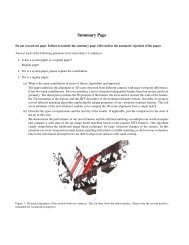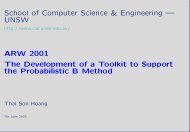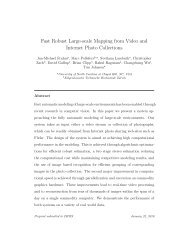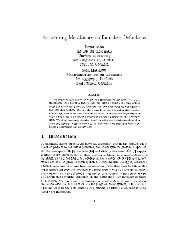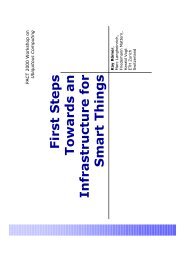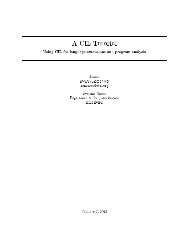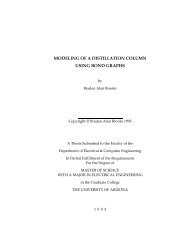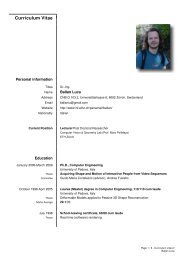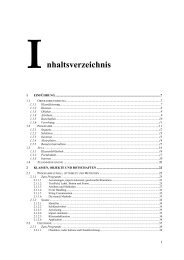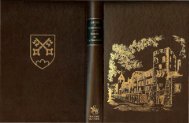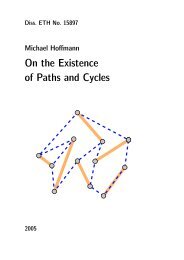Structure and motion from image sequences - Department of ...
Structure and motion from image sequences - Department of ...
Structure and motion from image sequences - Department of ...
You also want an ePaper? Increase the reach of your titles
YUMPU automatically turns print PDFs into web optimized ePapers that Google loves.
<strong>Structure</strong> <strong>and</strong> <strong>motion</strong> <strong>from</strong> <strong>image</strong> <strong>sequences</strong><br />
Marc Pollefeys, Maarten Vergauwen, Kurt Cornelis,<br />
Jan Tops, Frank Verbiest, Luc Van Gool<br />
Centre for Processing <strong>of</strong> Speech <strong>and</strong> Images, K.U.Leuven,<br />
Kasteelpark Arenberg 10, B-3001 Leuven-Heverlee, Belgium<br />
Abstract. In this paper an approach is presented that obtains virtual models <strong>from</strong> <strong>sequences</strong><br />
<strong>of</strong> <strong>image</strong>s. The system can deal with uncalibrated <strong>image</strong> <strong>sequences</strong> acquired with a h<strong>and</strong> held<br />
camera. Based on tracked or matched features the relations between multiple views are<br />
computed. From this both the structure <strong>of</strong> the scene <strong>and</strong> the <strong>motion</strong> <strong>of</strong> the camera are<br />
retrieved. The ambiguity on the reconstruction is restricted <strong>from</strong> projective to metric through<br />
auto-calibration. A flexible multi-view stereo matching scheme is used to obtain a dense<br />
estimation <strong>of</strong> the surface geometry. From the computed data virtual models can be<br />
constructed or, inversely, virtual models can be included in the original <strong>image</strong>s.<br />
Keywords: <strong>Structure</strong> <strong>from</strong> <strong>motion</strong>, <strong>image</strong> <strong>sequences</strong>, 3D models.<br />
1 Introduction<br />
In recent years the emphasis for applications <strong>of</strong> 3D modelling has shifted <strong>from</strong> measurements<br />
to visualization. New communication <strong>and</strong> visualization technology have created an important<br />
dem<strong>and</strong> for photo-realistic 3D content. In most cases virtual models <strong>of</strong> existing scenes are<br />
desired. This has created a lot <strong>of</strong> interest for <strong>image</strong>-based approaches. Applications can be<br />
found in e-commerce, real estate, games, post-production <strong>and</strong> special effects, simulation, etc.<br />
For most <strong>of</strong> these applications there is a need for simple <strong>and</strong> flexible acquisition procedures.<br />
Therefore calibration should be absent or restricted to a minimum. Many new applications<br />
also require robust low cost acquisition systems. This stimulates the use <strong>of</strong> consumer photoor<br />
video cameras. Some approaches have been proposed for extracting 3D shape <strong>and</strong> texture<br />
<strong>from</strong> <strong>image</strong> <strong>sequences</strong> acquired with a freely moving camera have been proposed. The<br />
approach <strong>of</strong> Tomasi <strong>and</strong> Kanade (1992) used an affine factorisation method to extract 3D<br />
<strong>from</strong> <strong>image</strong> <strong>sequences</strong>. An important restriction <strong>of</strong> this system is the assumption <strong>of</strong><br />
orthographic projection. Another type <strong>of</strong> approach starts <strong>from</strong> an approximate 3D model <strong>and</strong><br />
camera poses <strong>and</strong> refines the model based on <strong>image</strong>s (e.g. Façade proposed by Debevec et al.<br />
(1996). The advantage is that fewer <strong>image</strong>s are required. On the other h<strong>and</strong> a preliminary<br />
model must be available <strong>and</strong> the geometry should not be too complex. The approach<br />
presented in this paper avoids most <strong>of</strong> these restrictions. The approach captures photorealistic<br />
virtual models <strong>from</strong> <strong>image</strong>s. The user acquires the <strong>image</strong>s by freely moving a camera<br />
around an object or scene. Neither the camera <strong>motion</strong> nor the camera settings have to be<br />
known a priori. There is also no need for preliminary models. The approach can also be used<br />
to combine virtual objects with real video, yielding augmented video <strong>sequences</strong>.<br />
2 Relating <strong>image</strong>s<br />
Starting <strong>from</strong> a collection <strong>of</strong> <strong>image</strong>s or a video sequence the first step consists in relating the<br />
different <strong>image</strong>s to each other. This is not an easy problem. A restricted number <strong>of</strong><br />
corresponding points is sufficient to determine the geometric relationship or multi-view
constraints between the <strong>image</strong>s. Since not all points are equally suited for matching or<br />
tracking (e.g. a pixel in a homogeneous region), the first step consists <strong>of</strong> selecting feature<br />
points (Harris <strong>and</strong> Stephens, 1988; Shi <strong>and</strong> Tomasi, 1994). Depending on the type <strong>of</strong> <strong>image</strong><br />
data (i.e. video or still pictures) the feature points are tracked or matched <strong>and</strong> a number <strong>of</strong><br />
potential correspondences are obtained. From these the multi-view constraints can be<br />
computed. However, since the correspondence problem is an ill-posed problem, the set <strong>of</strong><br />
corresponding points can be contaminated with an important number <strong>of</strong> wrong matches or<br />
outliers. In this case, a traditional least-squares approach will fail <strong>and</strong> therefore a robust<br />
method is used (Torr, 1995; Fishler <strong>and</strong> Bolles, 1981). Once the multi-view constraints have<br />
been obtained they can be used to guide the search for additional correspondences. These can<br />
then be used to further refine the results for the multi-view constraints.<br />
3 <strong>Structure</strong> <strong>and</strong> <strong>motion</strong> recovery<br />
The relation between the views <strong>and</strong> the correspondences between the features, retrieved as<br />
explained in the previous section, will be used to retrieve the structure <strong>of</strong> the scene <strong>and</strong> the<br />
<strong>motion</strong> <strong>of</strong> the camera. The approach that is used is related to the approach proposed by<br />
Beardsley et al. (1997) but is fully projective <strong>and</strong> therefore not dependent on the quasi-<br />
Euclidean initialisation. This is achieved by strictly carrying out all measurements in the<br />
<strong>image</strong>s, i.e. using reprojection errors instead <strong>of</strong> 3D errors. To support initialisation <strong>and</strong><br />
determination <strong>of</strong> close views (independently <strong>of</strong> the actual projective frame) an <strong>image</strong>-based<br />
measure to obtain a qualitative evaluation <strong>of</strong> the distance between two views had to be used.<br />
The proposed measure is the minimum median residual for a homography between the two<br />
views. At first two <strong>image</strong>s are selected <strong>and</strong> an initial projective reconstruction frame is set-up<br />
(Faugeras, 1992; Hartley et al. 1992). Then the pose <strong>of</strong> the camera for the other views is<br />
determined in this frame <strong>and</strong> for each additional view the initial reconstruction is refined <strong>and</strong><br />
extended. This is illustrated in Figure 1.<br />
Figure 1 The pose estimation <strong>of</strong> a new view uses inferred structure-to-<strong>image</strong> matches.
In this way the pose estimation <strong>of</strong> views that have no common features with the reference<br />
views also becomes possible. Typically, a view is only matched with its predecessor in the<br />
sequence. In most cases this works fine, but in some cases (e.g. when the camera moves back<br />
<strong>and</strong> forth) it can be interesting to also relate a new view to a number <strong>of</strong> additional views.<br />
C<strong>and</strong>idate views are identified using the <strong>image</strong>-based measure mentioned above. Once the<br />
structure <strong>and</strong> <strong>motion</strong> has been determined for the whole sequence, the results can be refined<br />
through a projective bundle adjustment (Triggs et al. 2000). Then the ambiguity is restricted<br />
to metric through auto-calibration (Triggs, 1997; Pollefeys, 1999b). Finally, a metric bundle<br />
adjustment is carried out to obtain an optimal estimation <strong>of</strong> the structure <strong>and</strong> <strong>motion</strong>.<br />
4 Dense surface estimation<br />
To obtain a more detailed model <strong>of</strong> the observed surface dense matching is used. The<br />
structure <strong>and</strong> <strong>motion</strong> obtained in the previous steps can be used to constrain the<br />
correspondence search. Since the calibration between successive <strong>image</strong> pairs was computed,<br />
the epipolar constraint that restricts the correspondence search to a 1-D search range can be<br />
exploited. Image pairs are warped so that epipolar lines coincide with the <strong>image</strong> scan lines.<br />
Dealing with <strong>image</strong>s acquired with a freely moving h<strong>and</strong>-held camera, it is important to use a<br />
calibration scheme that works for arbitrary <strong>motion</strong>s (Pollefeys et al., 1999a). In addition, this<br />
approach guarantees minimal <strong>image</strong> sizes. The correspondence search is then reduced to a<br />
matching <strong>of</strong> the <strong>image</strong> points along each <strong>image</strong> scan-line. An example <strong>of</strong> a rectified stereo<br />
pair is given in Figure 2. It was recorded with a h<strong>and</strong>-held digital video camera in the<br />
Béguinage in Leuven. Due to the narrow streets only forward <strong>motion</strong> is feasible. This would<br />
have caused st<strong>and</strong>ard homography-based rectification approaches to fail.<br />
In addition to the epipolar geometry other constraints like preserving the order <strong>of</strong><br />
neighbouring pixels, bi-directional uniqueness <strong>of</strong> the match, <strong>and</strong> detection <strong>of</strong> occlusions can<br />
be exploited. These constraints are used to guide the correspondence towards the most<br />
probable scan-line match using a dynamic programming scheme (Cox et al. 1996). The<br />
matcher searches at each pixel in one <strong>image</strong> for maximum normalized cross correlation in the<br />
other <strong>image</strong> by shifting a small measurement window along the corresponding scan line.<br />
Matching ambiguities are resolved by exploiting the ordering constraint in the dynamic<br />
programming approach (Koch, 1996). The algorithm was further adapted to employ extended<br />
neighbourhood relationships <strong>and</strong> a pyramidal estimation scheme to reliably deal with very<br />
large disparity ranges <strong>of</strong> over 50% <strong>of</strong> <strong>image</strong> size (Falkenhagen, 1997). The disparity search<br />
range is limited based on the disparities that were observed for the features in the structure<br />
<strong>and</strong> <strong>motion</strong> recovery.<br />
The pairwise disparity estimation allows computing <strong>image</strong>-to-<strong>image</strong> correspondence between<br />
adjacent rectified <strong>image</strong> pairs <strong>and</strong> independent depth estimates for each camera viewpoint.<br />
An optimal joint estimate is achieved by fusing all independent estimates into a common 3D<br />
model using a Kalman filter. The fusion can be performed in an economical way through<br />
controlled correspondence linking. This approach was discussed more in detail in (Koch et al.<br />
1998). This approach combines the advantages <strong>of</strong> small baseline <strong>and</strong> wide baseline stereo. It<br />
can provide a very dense depth map by avoiding most occlusions. The depth resolution is<br />
increased through the combination <strong>of</strong> multiple viewpoints <strong>and</strong> large global baseline while the<br />
matching is simplified through the small local baselines.
Figure 2 Béguinage sequence: Rectified <strong>image</strong> pair (left) <strong>and</strong> some views <strong>of</strong> the reconstructed street model<br />
obtained <strong>from</strong> several <strong>image</strong> pairs (right).<br />
5 Building virtual models<br />
In the previous sections a dense structure <strong>and</strong> <strong>motion</strong> recovery approach was given. This<br />
yields all the necessary information to build photo-realistic virtual models. The 3D surface is<br />
approximated by a triangular mesh to reduce geometric complexity <strong>and</strong> to tailor the model to<br />
the requirements <strong>of</strong> computer graphics visualization systems. A simple approach consists <strong>of</strong><br />
overlaying a 2D triangular mesh on top <strong>of</strong> one <strong>of</strong> the <strong>image</strong>s <strong>and</strong> then build a corresponding<br />
3D mesh by placing the vertices <strong>of</strong> the triangles in 3D space according to the values found in<br />
the corresponding depth map. The <strong>image</strong> itself is used as texture map. If no depth value is<br />
available or the confidence is too low the corresponding triangles are not reconstructed. The<br />
same happens when triangles are placed over discontinuities. This approach works well on<br />
dense depth maps obtained <strong>from</strong> multiple stereo pairs <strong>and</strong> is illustrated in Figure 3. The<br />
texture itself can also be enhanced through the multi-view linking scheme. A median or<br />
robust mean <strong>of</strong> the corresponding texture values can be computed to discard imaging<br />
artefacts like sensor noise, specular reflections <strong>and</strong> highlights.
Figure 3 Surface reconstruction approach (top): A triangular mesh is overlaid on top <strong>of</strong> the <strong>image</strong>. The<br />
vertices are back-projected in space according to the depth values. From this a 3D surface model is<br />
obtained (bottom).<br />
To reconstruct more complex shapes it is necessary to combine multiple depth maps. Since<br />
all depth-maps can be located in a single metric frame, registration is not an issue. In some<br />
cases it can be sufficient to load the separate models together in the graphics system. For<br />
more complex scenes it can be interesting to first integrate the different meshes into a single<br />
mesh. This can for example be done using the volumetric technique proposed in (Curless <strong>and</strong><br />
Levoy, 1996). Alternatively, when the purpose is to render new views <strong>from</strong> similar<br />
viewpoints <strong>image</strong>-based approaches can be used (Koch et al. 2001). This approach avoids<br />
the difficult problem <strong>of</strong> obtaining a consistent 3D model by using view-dependent texture <strong>and</strong><br />
geometry. This also allows taking more complex visual effects such as reflections <strong>and</strong><br />
highlights into account.<br />
5 Examples <strong>and</strong> applications<br />
The Indian temple sequence was shot in Ranakpur (India) using a st<strong>and</strong>ard Nikon F50 photo<br />
camera <strong>and</strong> then scanned. The sequence seen at the left <strong>of</strong> Figure 4 was processed through<br />
the method presented in this paper. The results can be seen on the right <strong>of</strong> Figure 4.<br />
Another challenging application consists <strong>of</strong> seamlessly merging virtual objects with real<br />
video. In this case the ultimate goal is to make it impossible to differentiate between real <strong>and</strong><br />
virtual objects. Several problems need to be overcome before achieving this goal. The most<br />
important <strong>of</strong> them is the rigid registration <strong>of</strong> virtual objects into the real environment. This<br />
can be done using the <strong>motion</strong> computation that was presented in this paper. A more detailed<br />
discussion <strong>of</strong> this application can be found in (Cornelis et al. 2001).
Figure 4 The Indian temple sequence (left), recovered sparse structure <strong>and</strong> <strong>motion</strong> (top-right) <strong>and</strong><br />
textured <strong>and</strong> a shaded view <strong>of</strong> the reconstructed 3D surface model (bottom-right).<br />
The following example was recorded at Sagalassos in Turkey, where footage <strong>of</strong> the ruins <strong>of</strong><br />
an ancient fountain was taken. The fountain video sequence consists <strong>of</strong> 250 frames. A large<br />
part <strong>of</strong> the original monument is missing. Based on results <strong>of</strong> archaeological excavations <strong>and</strong><br />
architectural studies, it was possible to generate a virtual copy <strong>of</strong> the missing part. Using the<br />
proposed approach the virtual reconstruction could be placed back on the remains <strong>of</strong> the<br />
original monument, at least in the recorded video sequence. The top part <strong>of</strong> Figure 5 shows a<br />
top view <strong>of</strong> the recovered structure before <strong>and</strong> after bundle-adjustment. Besides the larger<br />
reconstruction error it can also be noticed that the non-refined structure is slightly bent. This<br />
effect mostly comes <strong>from</strong> not taking the radial distortion into account in the initial structure<br />
recovery. In the rest <strong>of</strong> Figure 5 some frames <strong>of</strong> the augmented video are shown.<br />
6 Conclusion<br />
In this paper an approach for obtaining virtual models with a h<strong>and</strong>-held camera was<br />
presented. The approach utilizes different components that gradually retrieve all the<br />
information that is necessary to construct virtual models <strong>from</strong> <strong>image</strong>s. Automatically<br />
extracted features are tracked or matched between consecutive views <strong>and</strong> multi-view<br />
relations are robustly computed. Based on this the projective structure <strong>and</strong> <strong>motion</strong> is<br />
determined <strong>and</strong> subsequently upgraded to metric through self-calibration. Bundle-adjustment<br />
is used to refine the results. Then, <strong>image</strong> pairs are rectified <strong>and</strong> matched using a stereo<br />
algorithm <strong>and</strong> dense <strong>and</strong> accurate depth maps are obtained by combining measurements <strong>of</strong><br />
multiple pairs. From these results virtual models can be obtained or, inversely, virtual<br />
models can be inserted in the original video.
Figure 5 Fusion <strong>of</strong> real <strong>and</strong> virtual fountain parts. Top: recovered structure before <strong>and</strong> after bundle<br />
adjustment. Bottom: 6 <strong>of</strong> the 250 frames <strong>of</strong> the fused video sequence.<br />
Acknowledgement<br />
Marc Pollefeys <strong>and</strong> Kurt Cornelis are respectively post-doctoral fellow <strong>and</strong> research assistant<br />
<strong>of</strong> the Fund for Scientific Research - Fl<strong>and</strong>ers (Belgium). The financial support <strong>of</strong> the FWO<br />
project G.0223.01, the ITEA BEYOND <strong>and</strong> the STWW VirtErf projects <strong>of</strong> the IWT <strong>and</strong> the<br />
IST-1999-26001 project VIBES are also gratefully acknowlegded.<br />
References<br />
1. P. Beardsley, A. Zisserman <strong>and</strong> D. Murray, Sequential Updating <strong>of</strong> Projective <strong>and</strong> Affine<br />
<strong>Structure</strong> <strong>from</strong> Motion, International Journal <strong>of</strong> Computer Vision (23), No. 3, Jun-Jul<br />
1997, pp. 235-259.<br />
2. K. Cornelis, M. Pollefeys, M. Vergauwen <strong>and</strong> L. Van Gool, Augmented Reality <strong>from</strong><br />
Uncalibrated Video Sequences, In M. Pollefeys, L. Van Gool, A. Zisserman, A.<br />
Fitzgibbon (Eds.), 3D <strong>Structure</strong> <strong>from</strong> Images - SMILE 2000, Lecture Notes in Computer<br />
Science, Vol. 2018, Springer-Verlag. 2001. pp.150-167.<br />
3. Cox, I., Hingorani, S. <strong>and</strong> Rao, S. A Maximum Likelihood Stereo Algorithm, Computer<br />
Vision <strong>and</strong> Image Underst<strong>and</strong>ing. 1996. Vol. 63, No. 3.<br />
4. B. Curless <strong>and</strong> M. Levoy. A Volumetric Method for Building Complex Models <strong>from</strong><br />
Range Images. Proc. SIGGRAPH. 1996. pp. 303-312.
5. P. Debevec, C. Taylor <strong>and</strong> J. Malik. Modelling <strong>and</strong> Rendering Architecture <strong>from</strong><br />
Photographs: A Hybrid Geometry- <strong>and</strong> Image-Based Approach. Proc. SIGGRAPH. 1996.<br />
pp. 11-20.<br />
6. L. Falkenhagen, Hierarchical Block-Based Disparity Estimation Considering<br />
Neighbourhood Constraints, Proc. International Workshop on SNHC <strong>and</strong> 3D Imaging,<br />
Rhodes, Greece, 1997. pp.115-122.<br />
7. O. Faugeras, What can be seen in three dimensions with an uncalibrated stereo rig,<br />
Computer Vision - ECCV'92, Lecture Notes in Computer Science, Vol. 588, Springer-<br />
Verlag, 1992, pp.563-578.<br />
8. M. Fischler <strong>and</strong> R. Bolles, RANdom SAmpling Consensus: a paradigm for model fitting<br />
with application to <strong>image</strong> analysis <strong>and</strong> automated cartography, Commun. Assoc. Comp.<br />
Mach., 1981, 24:381-95.<br />
9. C. Harris <strong>and</strong> M. Stephens, A combined corner <strong>and</strong> edge detector, Fourth Alvey Vision<br />
Conference, 1988, pp.147-151.<br />
10. R. Hartley, R. Gupta, <strong>and</strong> T. Chang. Stereo <strong>from</strong> uncalibrated cameras. Proc. Conference<br />
Computer Vision <strong>and</strong> Pattern Recognition, pp. 761-764, 1992.<br />
11. R. Koch, Automatische Oberflachenmodellierung starrer dreidimensionaler Objekte aus<br />
stereoskopischen Rundum-Ansichten, PhD thesis, Univ. <strong>of</strong> Hannover, Germany, 1996.<br />
12. R. Koch, M. Pollefeys <strong>and</strong> L. Van Gool. Multi Viewpoint Stereo <strong>from</strong> Uncalibrated<br />
Video Sequences. Proc. European Conference on Computer Vision, 1998, pp.55-71.<br />
13. R. Koch, B. Heigl, M. Pollefeys, Image-based rendering <strong>from</strong> uncalibrated lightfields<br />
with scalable geometry, in R. Klette, T. Huang, G. Gimel´farb (Eds.), Multi-Image<br />
Analysis, Lecture Notes in Computer Science, Vol. 2032, 2001, pp.51-66.<br />
14. M. Pollefeys, R. Koch <strong>and</strong> L. Van Gool, A simple <strong>and</strong> efficient rectification method for<br />
general <strong>motion</strong>, Proc.ICCV, 1999. pp.496-501.<br />
15. M. Pollefeys, R. Koch <strong>and</strong> L. Van Gool. Self-Calibration <strong>and</strong> Metric Reconstruction in<br />
spite <strong>of</strong> Varying <strong>and</strong> Unknown Internal Camera Parameters, International Journal <strong>of</strong><br />
Computer Vision, 32(1). 1999. pp.7-25.<br />
16. J. Shi <strong>and</strong> C. Tomasi, Good Features to Track, Proc. Conference on Computer Vision <strong>and</strong><br />
Pattern Recognition. 1994. pp. 593 - 600.<br />
17. C. Tomasi <strong>and</strong> T. Kanade, Shape <strong>and</strong> <strong>motion</strong> <strong>from</strong> <strong>image</strong> streams under orthography: A<br />
factorization approach, International Journal <strong>of</strong> Computer Vision, 9(2): 137-154, 1992.<br />
18. P. Torr, Motion Segmentation <strong>and</strong> Outlier Detection, PhD Thesis, Dept. <strong>of</strong> Engineering<br />
Science, University <strong>of</strong> Oxford, 1995.<br />
19. B. Triggs, The Absolute Quadric, Proc. Conference on Computer Vision <strong>and</strong> Pattern<br />
Recognition, 1997, pp.609-614.<br />
20. B. Triggs, P. McLauchlan, R. Hartley, A. Fiztgibbon, Bundle Adjustment -- A Modern<br />
Synthesis, In B. Triggs, A. Zisserman, R. Szeliski (Eds.), Vision Algorithms: Theory <strong>and</strong><br />
Practice, LNCS Vol.1883, pp.298-372, Springer-Verlag, 2000.



